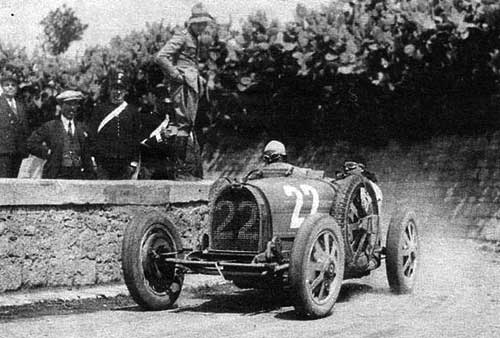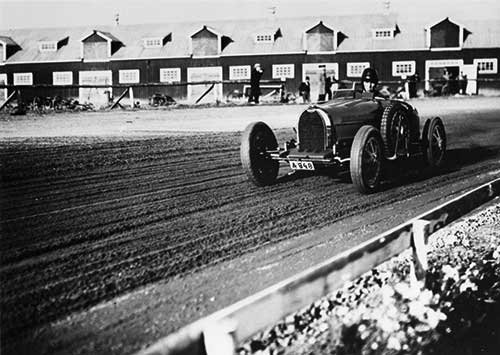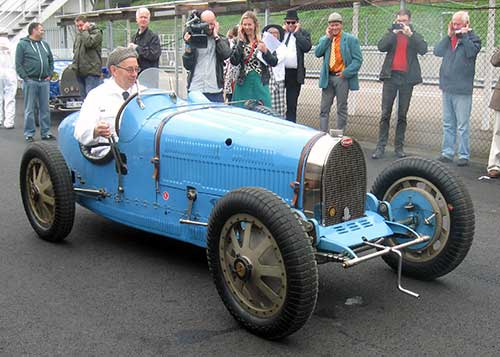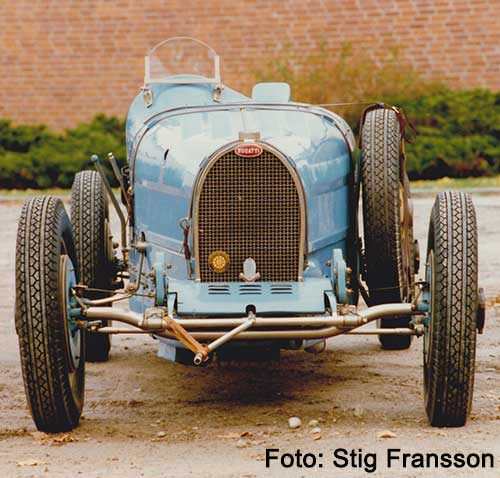|
The Bugatti Type 35 is often considered to be
the world’s most beautiful racing car and there
is hardly anyone who managed to produce a race
car with so beautiful lines as Ettore Bugatti -
the lovely horseshoe-shaped radiator that
adorned his cars showed his interest in horses.
Le Pur Sang, the French words for thoroughbreds,
is also widely used for the cars he built in Molsheim,
Alsace, south of Strasbourg.
Bugatti Type 35 (found in several versions)
debuted in 1924
in the competition for
the French Grand Prix. Cars of this type then
during the 20s and 30s
won thousands
of competitions in the hands of factory and
private drivers.
Throughout the production time different
versions featured in the Bugatti
sales catalogues and could be bought "over the
counter" - if you had enough money.
The 35B engine is the largest and strongest
version, a 2,3 litre supercharged
straight-eight (two 4-cylinder blocks) that
develops 140 hp at
about 5,500 rpm. The
crankshaft is a veritable precision work, of
eight parts running in three ball bearings and
two large roller bearings. The engine has a
single overhead camshaft and each cylinder has
two intake and one exhaust valve. The car weighs
about 750 kilograms and accelerates from 0-100
km/h in about 7 seconds.
Typical for Bugatti is the beautiful, curved,
tubular front axle. Most type 35 cars had the
aluminium wheels with centre locking, moulded in
one piece with the brake drum.
Our car was
first owned and registered by the factory
and took part in the 1929 Targa Florio
race with Louis Wagner at the wheel. Sadly he
was not able to finish the race. By this time,
the driver was often accompanied by a mechanic
on the races and therefore the car is a
two-seater.
In July 1929 the car was sold to the renowned
French racing driver Louis Chiron, who possibly
used it for training of race drivers.
The car came to Sweden in 1931, imported by the
Swedish racing driver K. G. Sundstedt. The car
long held the Swedish
speed record on the flying kilometre by 181
km/h, sat on a straight road outside
Ystads Havsbad in the middle of the 1930s. It
was run in many types of competitions, among
others in ice-racing as the Rämen races
(Swedish Winter Grand Prix) and it had a very
successful racing career in Sweden, Norway and
Finland.
After the war the car was badly treated by
several owners, and when in the early 1950s
bought by Bertil Lindblad in a very poor
condition. The engine, however, had been
overhauled in England. The car was restored by
Bertil Lindblad, but it was not started before
his death.
Since the car was donated to the foundation in
the 1990s, it has been given a thorough
overhaul, including engine, and was started for
the first time in 2010. The light blue
(the french racing colour) car
has participated in several demonstration
races at Swedish racetracks. Bugatti cars of
this type are still used with great success in
competitions for historic racing cars.
|
Technical
data |
|
Make:
Bugatti |
|
Type/Model:
35B |
|
Body:
2-seater race
car |
|
Year of
manufacture:
1929 |
|
Engine:
8-cylinder
in-line engine
with an overhead
camshaft |
|
Cylinder
capacity:
2262 cc |
|
Power:
about 130 hk? |
|
Gearbox:
4-shift plus
back,
unsynchronized |
|
Brakes:
Mechanical
4-wheel brakes |
|
Wheelbase:
2400 mm |
|
Maximum
speed:
2XX km/h |
|
Manufactured
Quantity:
340 (all
types 35 and 39) |
|

Louis Wagner med Bugatti typ
35B 4922 i 1929 års Targa Florio-tävling.

K.G. Sundstedt med
Bugatti typ 35B 4922 vid tävling på Solvalla.

Stiftelsens Bugatti
typ 35B 4922 på uppvisning på Knutstorps racerbana
2014.
 |